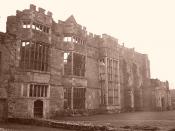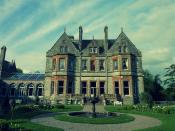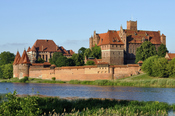CASTLES:
OF THE MEDIEVAL ERA
Not so long ago, there was a period in time where kings ruled the lands and knights took their directions. The feudal system was thriving and life was good. This time was the Middle Ages. The Middle Ages took their effect in the thirteenth, fourteenth, and fifteenth centuries. During this time, kings and lords built large forts to protect their strongholds. However, they were more than just forts. They were giant buildings of war; buildings called castles.
WHAT IS A CASTLE?
As you probably already know, or have inferred, the word, "castle" comes from a Latin word meaning "fortress". With their origin stretching back to the ninth century, castles were used by kings, lords, and nobles to strengthen their strongholds within the castle's infrastructure.
The stronghold was where the king or lord lived and also stood as the most vital structure of the entire castle.
The castle itself was basically, just a large wall around the stronghold, but it proves to be much more. Later, castles became very important in Western Europe in the late A.D. 900's and the 1000's. They played a central role in the political and military system called feudalism. In the Middle Ages, Europe was divided into many small states, and local conflicts were common. A castle helped the owner or owners defend the land where the castle stood. It also provided a home for the monarch or noble's family and servants. In addition, a castle served as a barracks, prison, storehouse, armory, treasure house, and center of local government. However, before the 1100's, most castles were made of timber and earth resources, but time grew on and enemies began attacking with unmerciful force. As the violence intensified, castles needed improved defense capabilities.
HOW DOES THE CASTLE PROVIDE DEFENSE?
In addition to providing support for defense of the stronghold, and occupants, castles now needed to defend everything else on the estate. For the castle was the heart and soul of the country. The king and queen and all of their loyal servants were inside, running the country. That's why villains would raid the castles for land or for money, knowing that they could hold the king and queen for ransom. Although, as new coming invaders made their way around Europe, the castle's assets now included the peasants/workers, equipment, crops, and the land itself. The castles stored much if not all of the master's wealth inside plus the acres of varying crops along the castle's perimeter. To a motivated enemy, castles had much to provide. At this point, anything outside of the castle or easily accessible inside of the castle was susceptible to the enemy's free will.
A majority of the castles already stood upon a natural or artificially created hill called a "motte". Often placed on hills to show prominence, strength, and wealth on the owner's part, but now, it was for advantage. A tower called a "keep" or "donjon" then stood with or nearby the castle on top of the motte as well. The keep, typically made of wood, was the castle's best-protected building and served as its last defense. In some cases, the castle holder's family and guards lived in the keep. Additionally, a "palisade", or wooden wall, enclosed the top of the motte offering full protection to those inside. Next, One of the greatest innovation castles now had were deep pits dug all the way around the castle. These ditches were then filled with water and named "moats". This new form of protection proved to be simple but effective; they were low maintenance but perfect for keeping the unwanted out.
Although, in order to get into the castle, a drawbridge had to be lowered that linked the castle with the land to allow people to cross the moats and enter. But as the enemies didn't let up, the castles added more protection. Now, to attack a castle, one had to break through the defenses of one or more "baileys", another type of defense structure, before they could reach the motte's defenses and both of those before they would even reach the moat! Although now in the 1100's, people began to build more and more castles out of stone. Stone castles provided much better protection from enemy's attacks, fires, and weather. In the late 1200's, strong stone walls and towers began to replace the keeps as the castle's main defenses. Advancements continued to take place as larger and stronger structures began replacing the smaller, weaker ones of the past. Guards were now a necessity as castles grew in size and wealth. Soon after, round towers stood at the corners of the castle's walls and along the lengths of the walls.
The guards walked along the tops of the walls and towers, where they were protected by defensive structures called "battlements". The battlements consisted of stone uprights known as "merlons" that shielded the guards from enemy missiles. Through the "crenels", the guards could shoot arrows or drop rocks on attackers. Many castles were also equipped with a new structure called a "gatehouse". Typically, the gatehouse consisted of two large towers, one on each side of the entrance, and one or more rooms above the entrance. From inside the gatehouse, guards could open and close huge doors that stood at the entrance. They could also raise and lower one or more, heavy metal gratings that blocked the entrance. The drawbridge also could be operated from inside this centralized control-room for defense.
HOW COULD THE INVADERS GET INTO THE CASTLE?
During these times of feudalism in Europe, monarchs and nobles depended on castles to provide safety and defense for themselves, their families, and their lands. Strong castles were very difficult to capture. The huge walls and the well-protected entrance withstood most first attacks. However, the enemies were advancing as well. With the use of a "siege", invaders had a better chance for gaining access. In a siege, enemy forces repeatedly attack a castle while cutting off all food, water, and help from outside. But it could take months to starve out a castle's defenders, and few attackers could mount and maintain a long siege. Enemies used devises that were no more than a large tree that had cut down with all the leaves and branches stripped off. Invaders slammed these trees into the drawbridges to knock them down despite the arduous labor involved. But for the one trying to gain access, the drawbridge was their main hope for entry, due to the fact that these castles were specifically created to keep people out.
HOW DID THE CASTLES KEEP INVADERS OUT?
Firstly, the moat was quite difficult to get past. In addition to being filled with water, deadly reptiles and fish defended the castle, plus sewage waste from the castle could be dumped into the moat too. Next, the walls of the castles could be from five to even twenty feet thick in some places and dozens of stories in height. Durability was the key. The purpose of the extremely high and dense walls was for defense from the enemies' high-impact weapons, crude explosives, and even those crazy enough to attempt climbing over. Hidden slits in the walls accompanied other portholes where silent arrows could be shot out or boiling liquids and other deadly objects could be dumped out onto enemies. Some castles had more than one gate for unknown escapes during these unbearable sieges. On some dire occasions, kings would escape through these hidden gates located somewhere towards the back of the castle. They were secret gates that were very hard to find, and only the king knew where the gates had been hidden.
The gate was used during a failing attack on the castle's part to escape from the siege. Additionally, it's interesting enough to know that some enemies would even try to tunnel into the castle fortification from a safe area out of view. Some of the castle's "kids" even had jobs listening in specific spots of the castle for sounds of digging by enemies. This helped the soldiers inside the castle to dig, meet, smoke or then kill the digging siege-men in the tunnel. Enemies would do whatever it took to get in to the castle, despite many failed attempts.
Although, even if an invader did get inside, there were thick barrier walls separating him from the stronghold within. Almost like a maze, only those experienced with the castle's placement could easily navigate.
WHAT WOULD AN INVASION BE LIKE?
After learning most of the structures and techniques used by defending castles, I can provide an example of a typical invasion.
If The Clan of Evil surprise attacked my castle, and even got passed my defense towers and keeps, I could still have a chance, despite the many things to do. First, as many crop-workers as possible would be called into the estate before the drawbridge would be brought up as the archers and swordsman would be called to attack. The archer's would go to the lookout towers of the castle and turrets to attack the progressing Clan of Evil. There would also be loopholes in the walls to shoot out of. Luckily, the moat would slow the soldiers down so the archer's could take down a lot of them. Many would even drown in the deep water because of the tremendous weight of their armor. Then, the outer wall and its built-in weapons would be used to slow the clan down even more. If they still persisted past the furious archers then hot oil would be dropped on all the soldiers in close proximity to the wall, while those trying to climb the wall would be severely burned and wounded.
Now, on the slight chance more invaders sneaked into the castle up an unprotected side, my expert swordsman would attack them. Most of the Clan of Evil that did get in would only get to the inside wall, nowhere even close to me, the king who was secretly hiding in an unknown passage. If the soldiers of the castle weren't doing well, then the peasants would have to suit up and attack the Clan as well. Boiling water and oil would continue to be dropped onto the soldiers seeking access below. However, the bond that we all share to the castle would remain impervious. My soldiers, guards, and peasants would not stop fighting until the last man standing. In most cases, there would be no mercy against the Clan of Evil if captured. Thanks to the bond between the castle's men, our defensive technology, and our urge to protect the "home-land", the castle would stand victorious. That is until the next invaders came along.
WHAT WERE THE CASTLE'S OTHER USES?
Castles also helped feudal lords maintain their rule over the lands around the castle. A monarch or noble could control a river crossing, mountain pass, or sea harbor by building a castle there. When a king wished to spread his power to new lands, he often built castles there to help control the new territory. The castle could even serve as a center for local government. The Peasants who farmed the land around the castle became tenants of the noble who lived in the castle. Their obligation to pay rent and to perform services also helped support the castle in addition to the agriculture income. For their labor, nobles protected the peasants during wartime and even held a court of law to settle disputes among the peasants.
As I hope you can tell from my essay, castles were great buildings of power and war. It took a lot to take out a castle, but it did occasionally happen. Both sides would fight hard in each of their different methods of offending or defending. Some castles were built so durably that they continue to stand today! In my opinion, without castles and their endless capabilities, the provinces of Europe probably would not have survived. Nor would have the system of feudalism that provided enough wealth for society to grow and advance to the point we're at in the present.


